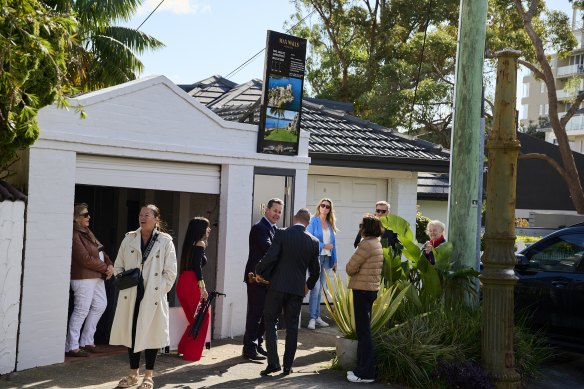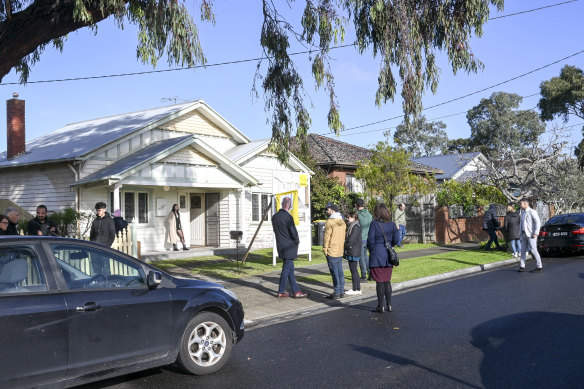‘Housing policy disaster’: Property approaches a tipping point
The days of 20 per cent plus rent hikes could be over, experts say, but the rental crisis is set to persist for years as tenants compete for properties.
The rental market appears to be at a tipping point as vacancy rates edge higher and the pace of rental growth slows, but there’s scant relief in sight for renters.

Australian housing policy has been described as a “disaster”.Credit: Michael Quelch
Australia’s rental vacancy rate edged up to 1.3 per cent in June from 1.2 per cent in May, SQM Research figures released on Tuesday showed.
Sydney’s vacancy rate ticked up to 1.7 per cent, Melbourne 1.5 per cent, Brisbane edged up to 1.1 per cent and Perth to a still ultra-low 0.8 per cent.
Although it remains a landlord’s market, SQM Research managing director Louis Christopher noted a shift.
Historically, vacancies have ticked up in June during a winter lull in the rental market, he said, but that seasonal impact disappeared in 2021 and 2022.
“The fact that this year we’ve recorded a seasonal increase is suggesting to us the rental market is starting to return to more normal activity levels,” he said.
“We are confident the days of 10 to 20 per cent annual rental increases in most of the cities have come to an end or [are] about to come to an end.
“We believe a lot of the bad news surrounding the rental market has now been priced-in to rents already.”
Tenants have responded to soaring rents by grouping together more, or moving out of cities to regional areas, or where possible, buying their first homes, he said.
“This has been priced into rents now, hence the reason why we’re confident we’re going to see rents return to more normal inflation trends,” or roughly inflation plus 1 per cent, he said.
But he warned the rental market is in severe shortage and is not expected to materially soften from its crisis for some years yet.
He also noted a tick-up in vacancy rates in the CBDs of Sydney, Melbourne, Canberra and Brisbane, saying student demand for rental accommodation may have peaked in this cycle as the rate of migration is expected to slow.
“Taking into account the extraordinary boost in demand we had when we opened our borders from students coming into Australia, I think we’ve been through that peak in student demand, and we’re returning to more normal levels,” he said.

Renters face a shortage of accommodation.Credit: Eddie Jim
Centre for Independent Studies chief economist Dr Peter Tulip agreed that the rent boom was tapering out, even as the crisis persists.
“Vacancies are unusually low. We have an extremely tight rental market, as any tenant who has gone to a rental inspection will know and be able to tell you. You still see queues running around the block for vacant properties so that means rents are going to continue increasing very quickly,” he said.
“They probably won’t sustain the extremely fast increases that we’ve seen over the past year or two, but they will be going up substantially faster than other prices and substantially faster than incomes, so the outlook for renters is a very grim one.
“We have a housing policy disaster in this country, and it’s going to get worse.”
He backed the NSW government’s push to enable more new housing, especially around train lines and called on other governments to follow suit.
“The shortages are not as severe as they were last year, but we still have a shortage.”
Domain chief of research and economics Dr Nicola Powell said the rental market had started turning a corner a number of months ago but would take months or years to rebalance.
“Over many months now, we have seen the vacancy rate nudging higher, and we have been seeing a slowdown in the pace of rental growth,” she said.
“The outlook is improving compared to what we saw in 2022, 2023. Absolutely, I think the 20 per cent annual increase in asking rents are a thing of the past,” she said.
In the June quarter, Sydney’s asking house rents held steady for the first time in a year and a half, according to Domain figures, while Melbourne’s house rent growth was the lowest annual gain since March 2023.
Net overseas migration is still high but coming off its peak, investors are buying, and households are adjusting since they cannot continue to manage such high annual increases. Some move into share houses or back in with their parents, she said.
“It is technically still a landlord’s market across Australia but what we’ve got is rental price growth has stabilised over the quarter,” she said.
“The affordability ceiling hasn’t been reached,” she said. “It’s been smashed.”